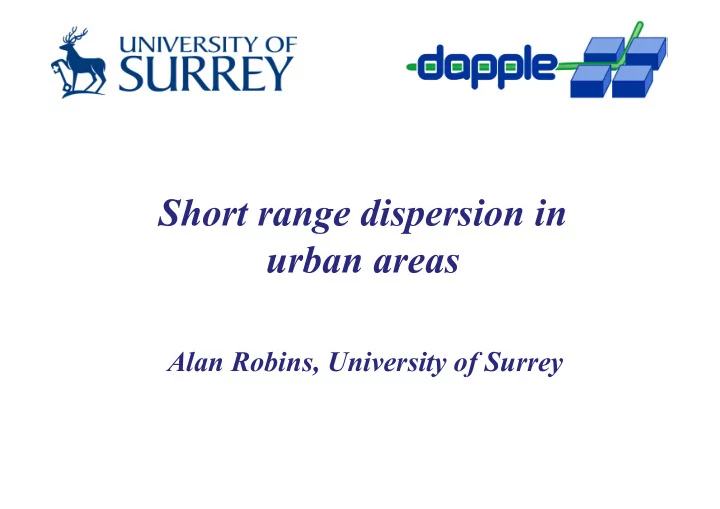

Short range dispersion in urban areas Alan Robins, University of Surrey
DAPPLE team Surrey - wind tunnel modelling, analysis Bristol - tracer studies, analysis Cambridge - tracer studies, modelling & applications Imperial - personal exposure, modelling & applications Leeds - traffic movement, emissions, pollution & wind field measurement Reading - meteorology, wind field & modelling Golder Associates (UK) Ltd.
Content From canyons to intersections - early work Some features of dispersion in cities using London as an example Some sensitivity studies Implications for regulatory/emergency response modelling
Four blocks Athena Scaperdas
Four blocks - velocity vectors U/U ref Measured Velocity Vectors (LDA) z/H = 0.16, Orientation = 10 degs
Four blocks - exchanges
Streets and intersections Where are the classical street canyons? The city as a set of short streets between intersections. Concentrate on the AURN Site intersections. Use London as an example (of a certain class of cities).
A simple model for generic use Initial wind tunnel model
Flow field
Mean flow field at an intersection Horizontal mean velocity vectors at heights of 5 and 20 m
Mean flow field at an intersection Mean velocity vectors at heights of 5 m
Mean flow field at an intersection Mean velocity vectors at heights of 5 m
Flow visualisation Flow ‘switching’ with diagonal winds - bimodal pdfs? Light sheet at about z/H = 0.3
Flow visualisation Vertical light sheet along centre of road along centre of road Horizontal light sheet near surface Vertical light sheet Source
Light sheet along Marylebone Road
Light sheet along Marylebone Road
Vertical sheet along Marylebone Rd
Vertical sheet along Marylebone Rd
Vertical sheet along Gloucester Pl
Vertical sheet along Gloucester Pl
Flow visualisation and LES 1. Exchanges through a street network 2. Loss/gain to flow above roof level.
Network models - SIRANE
Flux balances - mean and turbulent U, U T , U N ? A d ) > c u < + C U ∫ ∫ (
SIRANE
Some empirical results C * = CU ( H ) H 2 / Q c '* = c ' U ( H ) H 2 / Q R * = R / H Separation Review C *( R / H ), c '*( R / H ) Ground level source in a boundary layer C * � ( R / H ) � N , N = 1.5 � 1.8 c '/ C � 0.5 � 0.7
Mean concentration C* = 12/R* 2 downwind sector only
Salt Lake City
Concentration fluctuations
Fluctuation intensity
Variability amongst realisations Single events (realisations) may differ greatly from the mean of a large number (ensemble) of repeated events. Receptor position 6- plume centre ensemble mean in white, realisations in red Field studies provide a Receptor position 1- plume edge collection of realisations … that are not part of a common ensemble.
Scatter plot for individual releases 1:1 correspondence
Sensitivity studies Monitor air quality where?
Model detail Comparison of results from low and higher resolution models; significant differences confined to short ranges.
Model detail Comparison of results from low and higher resolution models; significant differences confined to short ranges.
Upwind model detail Generic upwind building arrangement Source ‘X’
Upwind model detail Concentrations, C*, across the main intersection for source at X, wind direction 51˚
Upwind model detail
Blocked streets Concentrations along Marylebone Road Reference; Wind direction blockage at A, B or -90, degs C; blockage at A, B & C. Green, reference; Wind direction blue, blockage at -45, degs A; red, at D; yellow at A & D.
Moving source Not a line source - a set of point sources. Roadside sampler locations Car speed profile during one experiment
Moving source
Empirical modelling Decay law � 2 � � R C * = 12 � � � � H Threshold R L � 2 R L R L � � C L * = 10 R L � � � � H Contaminated region 1/2 � � 10 “Source” Upwind R L = H � � street spread � C L * �
Regulatory level modelling Exchanges at intersections are a fundamental feature Near-classical canyon conditions within about a street width Substantial fluxes above roof level (even at short range) Substantial parameter data base to acquire and test Then add isolated tall buildings, open spaces, etc.
Advanced level modelling Relatively weak sensitivity to model detail Generic upwind conditions appear adequate Substantial unsteadiness Intermittent dispersion process important Provision of parameters for regulatory level models
Some questions Choice of reference wind Street roughness elements (buses, trees …) Evaluation against field data Unsteady source terms Thermal effects, light winds, traffic
One person’s experience of an urban concentration field
Recommend
More recommend